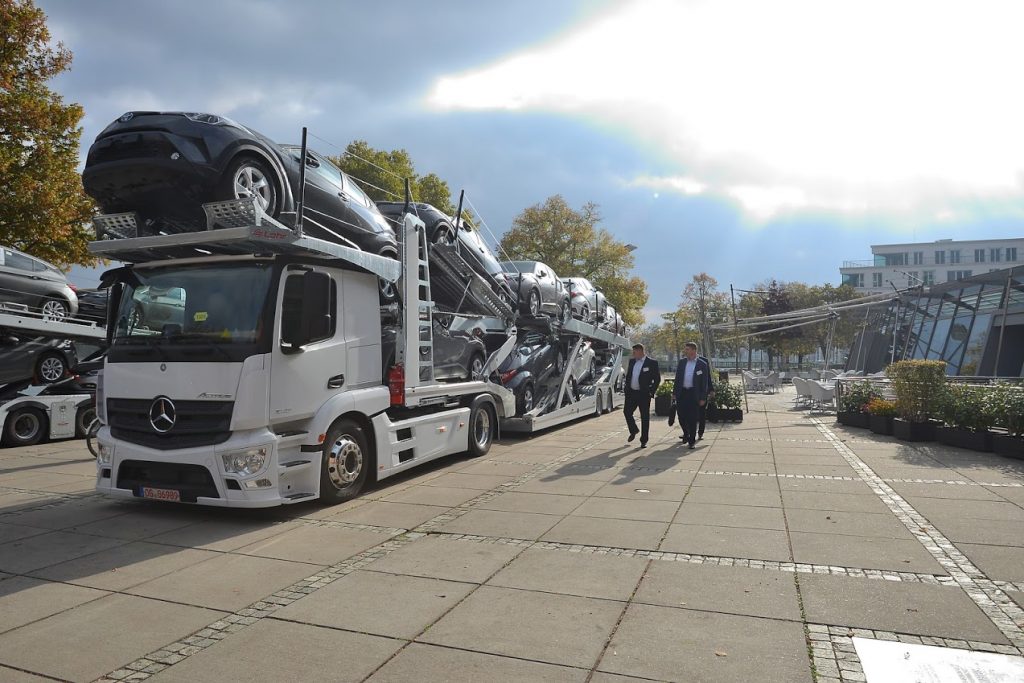Europe’s finished vehicle sector faces several big challenges in coming months, as speakers at the recent ECG conference in Germany made clear. Marcus Williams reports
 The finished vehicle sector in Europe is dealing with some major challenges at the moment, including an increasingly serious driver shortage, severe fluctuations in capacity demand because of the new emissions test that came in this September, and the introduction in 2020 of a global cap on sulphur content in marine fuels of 0.5%. There is also the continued uncertainty and potential disruption caused to the sector by the UK’s exit from the European Union next year. At last week’s annual conference of the Association of European Vehicle Logistics (ECG), held in Mainz, Germany, speakers discussed what they were doing to tackle these problems.
The finished vehicle sector in Europe is dealing with some major challenges at the moment, including an increasingly serious driver shortage, severe fluctuations in capacity demand because of the new emissions test that came in this September, and the introduction in 2020 of a global cap on sulphur content in marine fuels of 0.5%. There is also the continued uncertainty and potential disruption caused to the sector by the UK’s exit from the European Union next year. At last week’s annual conference of the Association of European Vehicle Logistics (ECG), held in Mainz, Germany, speakers discussed what they were doing to tackle these problems.In terms of the driver shortage, ECG’s president Wolfgang Göbel presented figures showing that over the next 10-15 years in Germany alone, 40% of truck drivers would be retiring, which given current trends meant a shortfall of 150,000 drivers. He also pointed out that the UK was already short by 45,000-52,000 drivers, with another 35,000 likely to retire in the next two years.
The urgent question is how to attract new people and retain them, and one of the main focuses for the ECG currently is on how to improve working conditions and welfare as a means to do so.
“It is very clear that we will not be able to find people for the job without the right environment,” said Göbel, who is also chief sales officer at German transport company Mosolf. “One of the main factors is that they have a safe and secure place to rest for the night.”
Secure networksDrivers on long hauls are all too often forced to park in insecure areas – even on the side of the motorway – or are moved on by police from truck parks, despite them being restricted by safety laws on the number of hours they can drive.

The ECG is working with its road haulage members to establish a network of compounds with facilities to eat and shower, to which drivers can gain access by using something similar to an e-gate or automated access tool. The association also has a Digitalisation Working Group that is developing an app drivers can use to access information relevant to their journey, including guidance on secure places to stop.
“We have discussed safer parking and the idea of a network of compounds among ECG members, where we are opening our compounds with an e-gate for member trucks to have access overnight, with such things as facilities to shower.”
The European Secure Truck Parking Organisation (Esporg) is also focused on building a network of secure and connected parking areas for drivers and, according to its general manager, Dirk Penasse, now has network of 70 members in 12 EU countries.
Its Study on Safe and Secure Parking Places for Trucks (SSTPA) surveyed truckers, transport companies, shippers and insurance companies, and introduced a new standard on parking areas with a uniform set of basic requirements and four levels of security, which are audited by independent third parties. Esporg is able to book the space for the driver and handle payment and route management.
Penasse emphasised that it was through the provision of improved working conditions that the sector might tackle the shortage of drivers and make sure there were enough people around to move an increasing volume of new cars. He said it was crucial to have the full participation of the industry as a whole to ensure these working conditions were improved.
 Dirk Penasse, general manager of the European Secure Truck Parking Organisation (Esporg)
Dirk Penasse, general manager of the European Secure Truck Parking Organisation (Esporg)Safety and skillsDrivers also need to be more secure in their daily practice. Toyota Europe’s general manager of vehicle logistics, Steve Thomas, is leading the Health and Safety Sub-Group, which is part of the ECG’s Operations Working Group. He outlined a number of measures the group was implementing to improve safety in what was a skilled yet demanding and sometimes dangerous job. For one thing, finished vehicle drivers are involved in a lot more tasks than those delivering standard freight, and have to load and unload cars on equipment that is three metres high and often in poor weather conditions.
The Health and Safety Sub-Group has a number of initiatives under way including a procedure for the sharing of information on accidents, a checklist and best practice code on safe loading of vehicles, and jointly established criteria for the safe use of the equipment on to which they are loaded. The working group includes participation from Renault and Toyota, as well as logistics providers Adampol, ECM, Gefco, Groupe Cat, Hoedlmayr and Mosolf. Equipment-makers Kassbohrer, Lohr and Rolfo are also represented.
Another challenge for the industry is in the shortage of skilled people, said Göbel, something he said the sector had to tackle as a whole as he appealed for a greater level of support.
“We are in a competition for the best young professionals to join our sector,” he said. “We have to convince people that our industry is the right one to work in. There are several associations in Germany and wider Europe and we are following the idea of a joint lobbying campaign to make jobs in finished vehicle logistics more attractive. ECG cannot do it alone, we need other partners.”
Discord in harmonyOne of the other major impacts on the finished vehicle sector this year has been the introduction of the Worldwide Harmonised Light Vehicle Test Procedure (WLTP) to measure CO2 emissions. The test, which came into force on September 1 and replaces the New European Driving Cycle (NEDC) test, introduces stricter criteria for testing, including higher average and maximum speeds, longer test distances and a greater range of driving situations.
 Steve Thomas, general manager of vehicle logistics at Toyota Motor Europe and lead on the ECG's Health and Safety Sub-Group
Steve Thomas, general manager of vehicle logistics at Toyota Motor Europe and lead on the ECG's Health and Safety Sub-GroupCarmakers have had to respond quickly to the new legislation, which was only approved for implementation in July this year and caught a lot of people by surprise. The stress on production and distribution has affected the finished vehicle sector quite dramatically.
Figures presented by Christoph Stürmer, global lead analyst at PwC Autofacts, showed that monthly vehicle registrations in August across Europe this year were up 268,000 on the same month in 2017 as dealers rushed to register their vehicles with the older NEDC certification before the new rules took effect in September. Parking lots were full of vehicles in the middle of this year and into the autumn, he said.
However, in September, there was a counter-effect from the pull forward on registrations and an insufficient number of Euro 6d-temp compliant vehicles, meaning numbers were down 344,000 on September 2017.
“In OEM parking lots the pre-built Euro 6d-temp cars were predominant but on the parking lots where cars sat that were owned by the retail system, it was mostly the older cars,” said Stürmer.
Stürmer said that WLTP had caused such disruption because the certification process was so complex.
“Every weight level and every powertrain combination needs to be certified separately,” he said. “I heard that the VW Golf has a seven-digit number of certifications to do just to get the full model line managed.”
 Christoph Stürmer, global lead analyst at PwC Autofacts
Christoph Stürmer, global lead analyst at PwC AutofactsThere are two aspects to this, according to Stürmer: one is the number of powertrain combinations and the other is the number of equipment combinations that changed the weight of the car.
“If you multiply that out for a VW Golf with around 100 powertrain combinations and [factor in] the equipment variations it is easy to understand why there are so many,” he said.
The combination of this complexity and the short notice meant the sector as whole was caught off guard and Stürmer said it was those dealing with registrations that were on “the bad side of bad” while logistics providers, by comparison, were on “the good side of bad”.
Either way, it is an ugly situation, including on the short-sea side of the business.[mpu_ad]
“I believe the entire industry of finished vehicle logistics providers and the OEMs were caught off guard,” said Bjorn Svenningsen, director of sales and marketing at UECC and the newly elected vice-president of the ECG. “There was not enough information about this available and our counterparts at the logistics departments at the OEMs had not done a good enough assessment.”
Time for dialogueWhat is worse is that the situation could be repeated next year when the Real Driving Emissions (RDE) standard, which covers NOx, particulate matter and all other toxic emissions in road-testing situations, is brought in. It will apply to all vehicles from September 1, 2019.
Svenningsen anticipated a similar struggle then and said the industry needed to create awareness and start a dialogue, not least with the OEMs.
Göbel lamented the way the situation was handled, with carmakers able to push cars out but logistics providers unable to ‘store’ services, with trucks either sitting idle when vehicles were not being moved, or unable to meet demand for services when the vehicles were released en masse – a fickle situation, according to Göbel, and one that was in danger of being repeated.
However, he agreed with Svenningsen about the need for dialogue and said addressing the problem was a good example of where the ECG could play its part.
“We can only try to learn from incidents that happen and make life easier for both sides. The level of collaboration in the industry is the best we’ve ever had with the OEMs,” said Göbel, adding that in the industry meetings the association had had with them, the OEMs were open and shared information.
Göbel also said he was keen to see the application of the association’s Project Caesar forecasting project to tackle expected capacity problems next year. Project Caesar is being developed by the Capacity Working Group and aims to tackle capacity shortages by improving forecasting methodologies. Göbel said it was based on a process of “permanent feedback” and an alignment of data that, in the long run, would make for more efficient use of capacity.
“Caesar is on its way,” he said. “There are trials with all modes of transport and the OEMs have joined in the trials. We will see after three or four months of trial what kind of adaptations should be made and we will roll out Caesar to all members and OEMs early next year.”
Clean billAnother legislative change relating to emissions that is going to have a massive effect on the finished vehicle logistics sector is the mandatory requirement set by the International Maritime Organisation (IMO) of a 0.5% cap on the sulphur content in marine oils from the beginning of January 2020.
 Christos Chryssakis, business development manager at DNV GL Maritime
Christos Chryssakis, business development manager at DNV GL MaritimeThe time for lobbying is over and ocean forwarders have been looking at a range of options to comply with the sulphur cap. Exhaust gas cleaning systems (or scrubbers) are being retrofitted at a price but as Christos Chryssakis, business development manager at DNV GL Maritime, told attendees in Mainz, by the deadline only 2,000 vessels will be equipped with scrubbers and the global fleet of vessels is nearer 90,000.
IMO estimates put the figure at 70,000 but either way, it leaves tens of thousands of vessels having to look for an alternative to the use of fuel under the current 3.5% sulphur limit. More specifically, those shipowners that are members of the ECG operate around 460 ships but each company is going to be greatly affected by the new rules, not only in terms of the method of compliance but also because of the operational challenges.
Other than scrubbers, those methods of compliance include the costly use of distillate fuels of 0.1% sulphur content, the purchase of new vessels that run on liquified natural gas (LNG), and the retrofitting of older vessels to run on LNG – all of which have significant cost implications.
Ocean forwarders are likely on the whole to switch to low sulphur blends of 0.5% but there is uncertainly on the blends that will available and just how available they will really be. As recently indicated by Emanuele Grimaldi, managing director of Italian shipping firm Grimaldi Group, global availability of lower sulphur blends remains uncertain and there are questions over the supply strategies of the companies making the fuel. Asked whether the refiners of the 0.5% fuel could artificially limit supply in order to maintain a higher price for it in the early days, Svenningsen admitted it was a possibility.
He also said the majority of the fuel oil being used today had a higher sulphur content, which was more or less a by-product of the normal refining process. Switching to a more sophisticated refining process was a challenge and the creation of a combined fuel required planning and investment, he added.
“There will be a major shift in the need for consumption of different fuel oils,” said Svenningsen. “It is going to be quite challenging and something that is very difficult to predict is what the spread of the price is. It is a game-changer for the shipping industry.”
Chryssakis said fuel costs would go up in 2020 and there would be an increase in the range of alternative fuels. He also said that because the fuel would be more expensive, the sector was likely to see longer transit times, as vessels would be slow-steaming. The winners, he predicted, will be those with modern, fuel-efficient ships, while older vessels would be scrapped as companies bit the bullet and invested in new-builds.
Chryssakis said shipowners needed to decide now which option they were going to take when it came to IMO compliance and prepare a ship-specific implementation plan that included risk assessment, fuel oil procurement and any necessary modifications to vessels for storage and handling. They also needed to assess the legal and commercial aspects of charters.
Best laid plansThe other shadow looming over the finished vehicle sector at the moment is the exit of the UK from the EU, due to take place at the end of March next year yet still riddled with uncertainty. Carmakers and their outbound logistics providers are looking for any sign that frictionless trade can be maintained, or at least evidence of what it is they have to prepare for. The situation is no clearer than it was when the ECG met last year in Brussels, however.
Mike Sturgeon, executive director of the ECG, said that there was a 50:50 chance the UK would leave the EU with a no-deal Brexit but suggested there was not much a carrier could do to prepare for it. That required investment at a national level in different infrastructure and involved customs border changes.
According to Arthur Maher, director of research at analyst LMC Automotive, the potential impact of a hard Brexit could include light vehicle sales in the UK dropping by 450,000 in 2020 compared to previous forecasts.
 Wolfgang Göbel was joined by Bjorn Svenningsen, director of sales and marketing at UECC, and the newly elected vice-president of the ECG
Wolfgang Göbel was joined by Bjorn Svenningsen, director of sales and marketing at UECC, and the newly elected vice-president of the ECGOn the subject of how IT could help in the movement of goods across the borders, there was not much reason for hope, according to Sturgeon. Citing a meeting the ECG had with customs members of the team under Michel Barnier, European chief negotiator on the UK exiting the EU, it was more a question of additional manpower.
Asked what was being done to make sure that technology could be used to minimise the impact on borders in any future trade, Sturgeon said the answer he received was that every country facing the UK was employing 10% more customs officers. “That means nobody is doing anything about making sure technology is in place but clearly, technology could make the borders quite manageable,” he said. “I think it is very disappointing that nobody seems to be doing anything to use technology to minimise potential problems at new borders.”
Svenningsen said there were technology companies emerging to propose solutions to the congestion he saw coming to the ports, however.
Figures from analyst LMC Automotive for last year show that the UK exported 700,000 light vehicles, while it imported 1.9m. Maher forecast that in planning for 2019, carmakers could start stockpiling vehicles and bringing production forward to accommodate the impact of Brexit in the early months of the year, which could push days of available supply upwards.
“BMW and Jaguar Land Rover are suspending their building in April next year,” observed Maher. “But they are not closing down dealers and stopping sales. The implication is they will bring forward production stock in early months of next year.”
According to Maher, days of supply is a barometer of health for the industry and should rest around 60 days; but contingency plans in Q1 to put an additional 200,000 units in stock would push that to 63 days.
The problem for the finished vehicle sector is that its customers are all at different stages of preparation for Brexit.
“Some are taking a proactive approach; others are not,” said Svenningsen. “We need to have dialogue on this and have everyone up to speed. However, it is uncertain and that is frustrating. How can you plan for something you don’t know about? It is a very big challenge for the industry.”

























![Global[1]](https://d3n5uof8vony13.cloudfront.net/Pictures/web/a/d/s/global1_726550.svgz)









